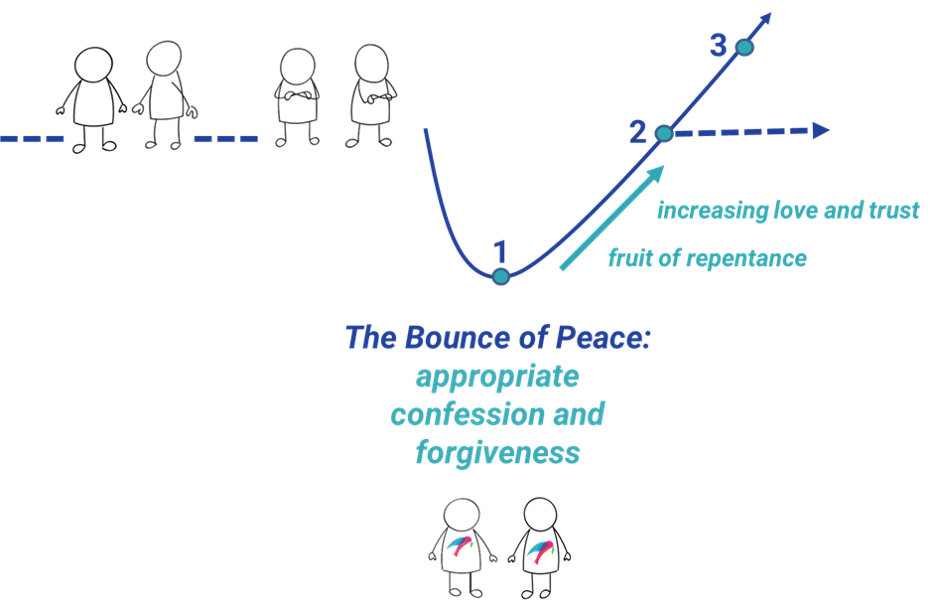The Bounce of Peace

What does the Bible mean by the phrase, “live at peace” or “live peaceably” with everyone?
I describe peace between two people as the point when each party admits whatever they did wrong to the other (if they did anything wrong), and each party forgives the other. You can say it in just four words: appropriate confession and forgiveness. If that is not your definition of peace, maybe you can agree that to reach appropriate confession and forgiveness is at least a good marker on the road to repair a relationship. Let me illustrate what I mean.
The dashed line in the diagram below represents the relationship level between two persons. The arrowhead on the dashed line indicates time moving from left to right. Starting from the picture on the left, the two people are interacting together at their normal relationship level. Then, sometime later their relationship is damaged by an offense or conflict. To illustrate this, the two people fold their arms and look away from each other. If neither one pursues peace, the warmth, closeness, and trust in their relationship will likely begin to fall below what it has been, as illustrated by the solid curved line below their feet.
Their warmth, closeness, and trust are likely to keep declining until one or both of them confess and/or forgive the incident that started the problem. That is point 1 at the bottom of the curve in the diagram. We call this moment of appropriate confession and forgiveness the “Bounce of Peace.” They have stopped the downward path of their relationship and they can start the climb back up.

After they reach the Bounce of Peace at point 1, they can then produce appropriate fruit of repentance and begin to rebuild love and trust. That is the time indicated by the upward line between points 1 and 2. Their relationship might improve right away, or stay at point 1 for a while. To be honest, they might not return to point 2. And, they may never achieve point 3, which symbolizes that their relationship is stronger and at a higher level than it was before their conflict.
In my years of experience, I have observed it is really, really hard for two people get to point 2 or 3 unless they have confessed and forgiven each other at point 1. That is why we describe peace as the point when two people have appropriately confessed and forgiven the relational offenses between them.
Of course, God wants you to go beyond simply arriving at the Bounce of Peace, especially with others who follow him. The Bible uses terms like having fellowship and growing in love for one another to describe these deeper levels of relationship. This is the area between points 1 and 2 on the diagram. You can know you have gone beyond the minimum level of peace when most of the time your relationship has unity, harmony, grace, blessing, gentleness, honor, respect, submission, confession, and forgiveness. These words describe what it means to maintain, preserve, and live in peace.
Even if the other person chooses not to co-operate, you can do your part toward appropriate confession and forgiveness. To pursue peace from your side means you first meet with God. You make the decision to forgive the person in your heart before the Lord. Second, if you have committed any biblically-defined wrong to the person, you confess it to them.
What does “live at peace” or “live peaceably” not mean?
The Bible describes a lack of peace with words like jealousy, strife, outbursts of anger, disputes, dissensions, discord, envy, factions, unruliness, rudeness, dishonor, disrespect, bitterness, disobedience, unconfessed sin, and unforgiven sin. Obviously, if you have these in your relationships, you are not at peace, and you must do what you can to make peace.
However, to be at peace with someone does not mean you have to be “best friends” with them. You treat them the way you want them to treat you (Matthew 7:12), and you do what you can to make sure there is no unconfessed sin or unforgiven sin between you.
Being at peace also does not mean you have to say, “I totally trust the other person in all circumstances.” You can be reconciled with a person over past relational problems, but sometimes you should be careful when you place your future trust in them. Let’s be honest. Some people are simply just not trustworthy in some areas of either their character or their competence.
What do I mean by character and competence? To trust in a person’s character means you have confidence that their morals, ethics, and motives have integrity and are consistently in line with biblical principles. You can then trust them to be honest and “do the right thing.” However, suppose I am a habitual, unreformed thief. You can forgive me for stealing from you, but you should not trust me with your money or valuables until I have proven that I am no longer a thief. Or, let’s say I am an unreformed gossip. You can forgive me for gossiping about you, but you should not entrust me with any information you don’t want others to hear until it is clear that I can control my tongue.
By trust in a person’s competence, I mean confidence in their skill or ability to complete a task. I may be an honest, ethical, and trustworthy person of godly character, but you should not trust my competence to do open heart surgery on you or to repair your car’s transmission. I don’t have competence in those skills.
